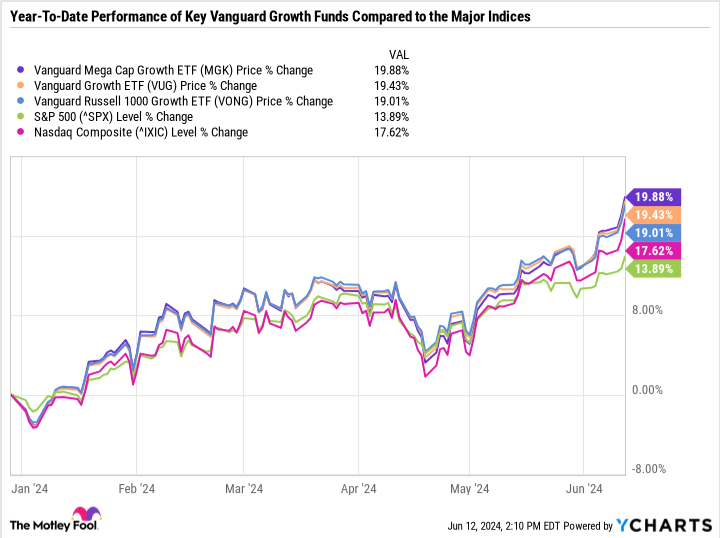Exchange traded funds (ETFs) can be excellent passive income vehicles, especially if they are cheap. Please take into account the Vanguard Russell 1000 Growth ETF (NASDAQ: VONG). The expense ratio is just 0.08%, meaning that $5,000 invested in the fund would only yield $4 in expenses per year.
The ETF hit an all-time high on Wednesday, along with a broader market rally. It’s one of Vanguard’s best-performing funds so far this year, up a whopping 19.3% compared to a 17.7% return for the Nasdaq Composite and 14% for the S&P500.
Here’s a primer on the exchange-traded fund and why it might be worth buying now.

Broad exposure through a growth lens
The Russell 1000 is a market capitalization-weighted index that includes the 1,000 largest U.S. companies. Given the top-heavy nature of the market, the Russell 1000 comprises approximately 93% of the total market capitalization of US stocks.
The Vanguard Russell 1000 Growth ETF essentially takes this pool of candidates and narrows it down to the most growth-oriented companies. It includes 440 stocks, so less than half of the Russell 1000. Here’s a look at the sector breakdown of the Vanguard Russell 1000 Growth ETF compared to the Vanguard Russell 1000 ETF (NASDAQ: VONE).
|
Sector |
Vanguard Russell 1000 Growth ETF |
Vanguard Russell 1000 ETF |
|---|---|---|
|
Technology |
53.4% |
32.8% |
|
Consumer discretionary |
18.8% |
14.1% |
|
healthcare |
10.2% |
11.7% |
|
Industrials |
9.7% |
12.9% |
|
Consumer goods |
2.6% |
4.8% |
|
Financial details |
2.5% |
10.8% |
|
Property |
0.8% |
2.4% |
|
Telecommunications |
0.6% |
2% |
|
Energy |
0.6% |
4.1% |
|
Basic materials |
0.4% |
1.8% |
|
Utilities |
0.4% |
2.6% |
Data source: Vanguard.
As you can see from the table, the Vanguard Russell 1000 Growth ETF has significantly lower weightings in value-oriented sectors such as financials. More than 70% of the fund is concentrated in technology and consumer discretionary, compared to less than 50% for the Russell 1000.
Other Vanguard Growth Funds to Consider
The Vanguard Russell 1000 Growth ETF is very similar in net assets to Vanguard’s largest growth fund: the Vanguard Growth ETF (NYSEMKT: VUG). The Vanguard Growth ETF essentially picks the most growth-oriented companies from the S&P 500. So a similar approach to the Vanguard Russell 1000 Growth ETF – only more concentrated in the largest companies.
It includes 200 components and a slightly lower expense ratio of 0.04% compared to 0.08% for the Vanguard Russell 1000 Growth ETF. The difference is small unless you have hundreds of thousands of dollars invested in these funds.
Ultimately, the best Vanguard growth fund for you depends on your desired concentration in the largest companies versus diversification into a larger pool of choices. For example, there is also the Vanguard Mega Cap Growth ETF (NYSEMKT: MGK) – which has just 79 positions and is even more focused on the most valuable US growth stocks by market capitalization. But as you can see from the chart, the Vanguard Russell 1000 Growth ETF, Vanguard Growth ETF, and Vanguard Mega Cap Growth ETF have all performed similarly this year.


A worthy passive income play if you can tolerate the volatility
The dominant trend of 2024 has been mega-cap growth, so it makes sense that growth-oriented funds – especially those concentrated in the largest market cap companies – are outperforming the S&P 500 and Nasdaq Composite.
However, the best use of a low-cost ETF is not to try to time the market based on what works in the short term, but to find a passive income vehicle that you like and feel comfortable with during periods of volatility .
Growth stocks tend to be more volatile than value and income stocks. Growth ETFs provide diversification, but it’s worth understanding that they can also fall more than major benchmarks during a correction or major stock market sell-off.
All three Vanguard ETFs discussed are good choices, but the Vanguard Russell 1000 Growth ETF could be the best choice if you want exposure to more companies and a little less concentration in the biggest names.
Should You Invest $1,000 in Vanguard Scottsdale Funds – Vanguard Russell 1000 Growth ETF Now?
Before buying shares in Vanguard Scottsdale Funds – Vanguard Russell 1000 Growth ETF, consider the following:
The Motley Fool stock advisor The analyst team has just identified what they think is the 10 best stocks for investors to buy now… and Vanguard Scottsdale Funds – Vanguard Russell 1000 Growth ETF wasn’t one of them. The ten stocks that survived the cut could deliver monster returns in the coming years.
Think about when Nvidia created this list on April 15, 2005… if you had $1,000 invested at the time of our recommendation, you would have $808,105!*
Stock Advisor provides investors with an easy-to-follow blueprint for success, including portfolio building guidance, regular analyst updates and two new stock picks per month. The Stock Advisor is on duty more than quadrupled the return of the S&P 500 since 2002*.
View the 10 stocks »
*Stock Advisor returns June 10, 2024
Daniel Foelber has no position in any of the stocks mentioned. The Motley Fool holds and recommends Vanguard Index Funds-Vanguard Growth ETF. The Motley Fool has a disclosure policy.
$5,000 in this Vanguard ETF carries only a $4 annual fee, and has beaten the S&P 500 and Nasdaq Composite in 2024. Originally published by The Motley Fool






